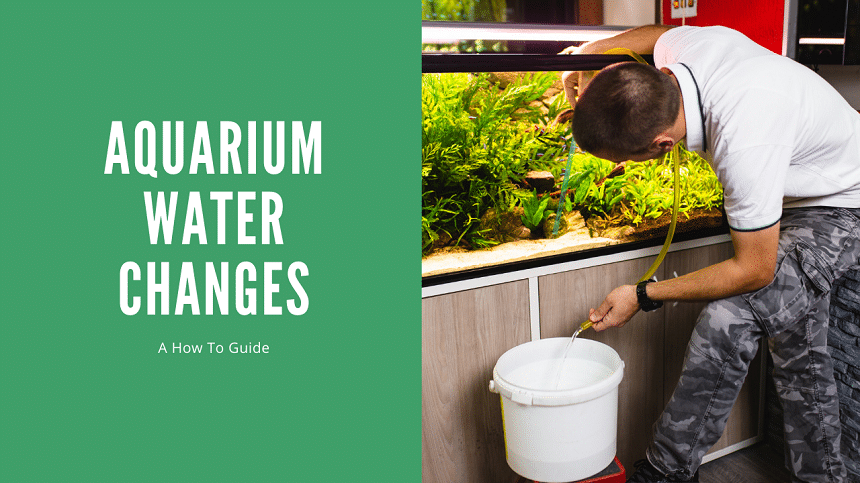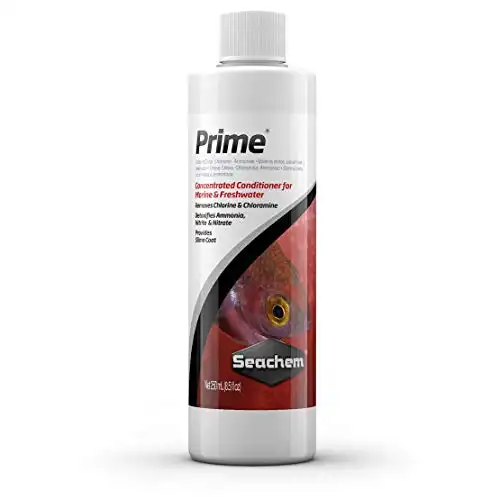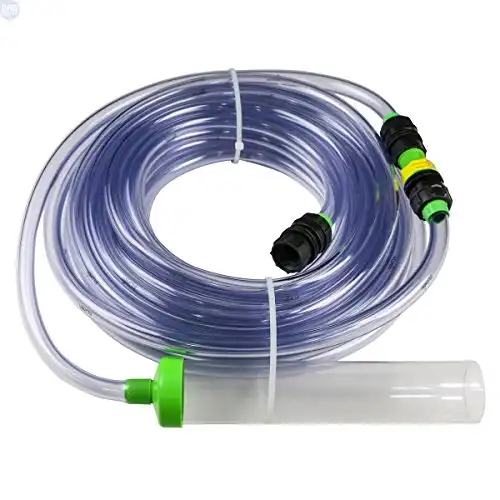Thank you for visiting! By the way… any links on this page that lead to products on Amazon and other stores/partners are affiliate links Aquarium Store Depot earns a commission if you make a purchase.
Performing an aquarium water change is the most important thing you can do to maintain a beautiful aquarium with healthy fish. For many aquarists, knowing when, and just how much water to change can be a bit of a guessing game.
In this article, I’ll be covering everything you need to know about water changing. So let’s dive right in!
What Is An Aquarium Water Change?
Changing water is the process of taking ‘dirty’ aquarium water out of your tank and replacing it with ‘clean’ water. This is something that all fish keepers and planted tank enthusiasts should do on a regular basis. Sure, it takes a little effort, but it’s a very important regular maintenance action to keep your fish healthy and your tank clean.
The 4 Benefits Of Doing This
If you aren’t already convinced, take a look at these important reasons for changing out the water in your aquarium:
1. Safer For Your Fish
Changing the water removes harmful toxins from your fish tank that cause poor water quality. This makes your aquarium a much safer and healthier home for your pets.
2. Reduced Algae
The toxins that build up in your aquarium water are a major cause of algae blooms. Performing regular partial water changes is one of the best ways to remove algae, and keep your water (and your glass) crystal clear.
3. Reset Nutrient Levels
If you grow aquatic plants in your freshwater aquarium, feeding them with supplements and fertilizers is a great way to promote the best growth and performance from them. Without testing for these nutrients, it’s hard to know exactly where the levels are, or if they are too high. Performing a water change is the easiest way of reducing the nutrients and trace elements to prevent them from building up.
4. A Clean Substrate
Fish waste and uneaten food tend to build up on the bottom of the tank and in your aquarium plants. Sucking water out of your freshwater tank is the best way to pull solid waste particles and sediment out of your aquarium.
The Nitrogen Cycle
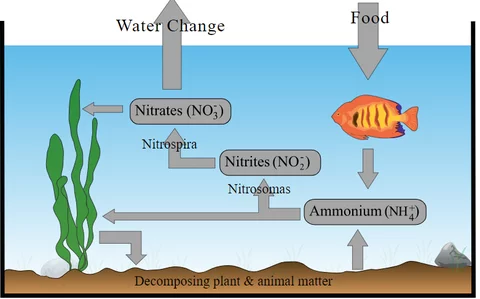
Water chemistry is a huge part of keeping a healthy, clean fish tank. If you find chemistry more frightening than fascinating, this side of the hobby can be pretty intimidating. The good news is that you don’t have to be a chemist to get the basics down.
There are some fundamentals that will really help you understand why water gets unsafe for your fish after a while. So it’s time to get just a little technical and learn these principles.
Basically, a fish tank is a closed system, so all the food you put into it either gets excreted by your fish as poop or sinks to the bottom and rots there. As it rots, it produces a nitrogen compound known as ammonia. Ammonia is toxic to your fish, but fortunately, the hardworking bacteria in your filter convert this subsetance into nitrite (also toxic), and then into nitrates.
Nitrates are not toxic to your fish in low concentrations, but they do build up over time and the best way to lower the levels is to literally remove them from the tank by changing the water. Once you understand this process, it’s easy to see why you need to do water changes!
If you’d like to know more about the nitrogen cycle, go ahead and check out my article on the aquarium cycle for a more in-depth look.
Water Change Schedules
Now that you understand the benefit of removing old aquarium water from your tank and adding new water, the obvious questions are:
- When should you change the water?
- How much water should You change?
Let’s take a look at the answers to these important questions:
Frequency
The main aim of the water change is to reduce nitrate levels in the water. The levels of this chemical compound are really what tell us when we need to change the aquarium water. As a general rule, nitrate levels of 15 parts per million(ppm) and below are considered safe for your fish, so that’s where we want to keep them.
But how do we know when the nitrate levels get too high?
Testing
The only way to know what your nitrate levels are is to test your water parameters. Luckily, this is really easy to do and all you need is a liquid or strip test kit. Use your test kit to test your water every week for ammonia, nitrites, and nitrates. If your tank is cycled, you should read :
- Ammonia: 0 ppm
- Nitrite: 0 ppm
- Nitrate: 1+ppm
When your nitrate level reaches 25+ ppm it’s time for your water change!
Volume
So you’ve tested your water and your nitrates are on the high side of healthy. You know it’s time for a water change, but just how much do you need to replace?
Let’s say, for example, you measure nitrates at 20 ppm and you want to get that down to a safer level of 10 ppm. If we assume (and it’s a fair enough assumption) that the nitrate is spread out pretty evenly in your tank’s water, all you need to do is take out half the water and replace it to get to that 10ppm level. Taking out half the water in your tank is also known as a 50% water change.
Factors Affecting Frequency And Volume
In practice, the amount of water you need to change, and how often you need to change it, will vary from tank to tank. It’s really all about how fast the nitrate levels build up in the aquarium water. Let’s take a look at what affects the rate of nitrate build-up in your fish tank water.
Stocking Levels
The more fish you have, the more waste (poop) they are going to produce. This means that if you want to have a lot of fish in your tank, you’re going to need to do more water changes than if you had fewer fish in a tank of the same size.
Another factor that can have an effect is the type of fish you have. A few fish species, like goldfish and plecos, for example, are known to produce more waste than other small fish. Many nano fish like tetras are light on a bioload. Shrimp and snails are very light on a stocking level.
Feeding
Fish food is another source of nitrates for your tank. If you’re putting too much food in your aquarium, and your fish don’t eat all of it, it’s going to rot and produce more nitrate.
Plant Density
It’s not only animals that have an effect on the nitrate levels in your tank. Live plants in freshwater tanks use nitrates and can help to reduce the levels in your aquarium water.
At the same time, plants will produce ammonia, and therefore nitrate, if they decay in your aquarium. In this way, plants can either decrease or increase nitrate levels in the fish tank water. In many aquascapes, plants will produce the most ammonia in the aquarium.
Dirty Filter Media
Dirty, clogged filter media can also be a source of nitrates in your aquarium. You need to rinse out the sponges in your water filter from time to time, but remember, the good bacteria that live in them are very important. Rinse out your filter media in the water you have taken out of the aquarium to keep them healthy.
Instructions
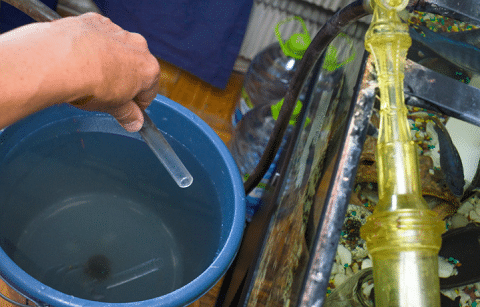
There are 3 main steps for successful aquarium water changing. Now that you know why water changes are so important, it’s time to get your hands wet!
What You’ll Need
Before we move on to the actual changing, here’s a list of things you’ll need for a simple water change using buckets:
- A bucket for preparing new water
- A bucket for removing old water(alternatively run the water straight into the yard through a window/door)
- An aquarium gravel vacuum water changer
- Water conditioner
- Aquarium fish bag/colander (optional)
- Thermometer (optional)
- Towels
1. Preparing
You should never just put any old water into your tank without preparing it first. The same amount of water that you will be taking out of your tank will have to be replaced, so figure out how much water you’re going to take out before you prepare new water.
Let’s take a look at how to prepare water:
Temperature
To avoid shocking your fish or other animals with a sudden change in water temperature, try to get the new water as close as possible to the same temperature as the aquarium water you’re going to take out. This is more important when you perform a water changes, and won’t make much difference if you’re only changing 10%.
If you have a mixer tap/faucet, this will make your life a lot easier. Using a spare water heater is also very effective.
Another simple method is to run cold water into a bucket and then add boiling water until it has reached the right temperature. Be very careful with boiling water and never pour it on your thermometer.
Dechlorinator/Conditioner
Tap water usually contains chlorine and chloramine, which are both toxic to your fish, plants, and the beneficial bacteria that keep the nitrogen cycle running in your tank. For this reason, aquarists need a way to neutralize these chemicals before this water can be safely added to the aquarium.
The good news is that this is easy to do and there are a few different products that can be used like API Tap Water Conditioner or Seachem Prime. These products are known as water conditioners and they neutralize a couple of other harmful chemicals and heavy metals too.
Seachem prime is a easy to use and affordable choice when it comes to remove chlorine and chloramines from your tap water. Highly recommended!
Unless you are using RO (Reverse osmosis) or RODI (for saltwater) water, I would definitely recommend using a water conditioner to be on the safe side, even if you’re running well water in your tanks.
You can condition your prepared water before you add it to your aquarium, or if you’re using a running water system or pumping it into your tank, you can also add your conditioner during or just after the change.
Saltwater
Reef and other saltwater tanks need water changes just like freshwater aquariums do. The major difference between fresh and saltwater aquariums is, of course, that you need to get the salinity of your water correct.
Make sure you mix in reef salt to the right concentration and use your refractometer to measure your salinity before adding new water to your tank. Bear in mind that as water evaporates, the salinity will increase, so top up your tank with fresh water to keep it full. Using tap water is not advised for saltwater aquariums.
2. Siphoning Your Tank
Now that your new water is prepared, it’s time to take some of the old, dirty water out. It is possible to remove water with a jug, but you’ll be leaving a whole lot of waste and sediment in the water. Using a pump to push water out of your tank is another option, but again you’re wasting a great chance to remove debris and give your tank a deep cleaning.
The solution is to siphon the old water out of your tank! But what is siphoning, and how do you do it? Read on for some handy tips.
Siphoning
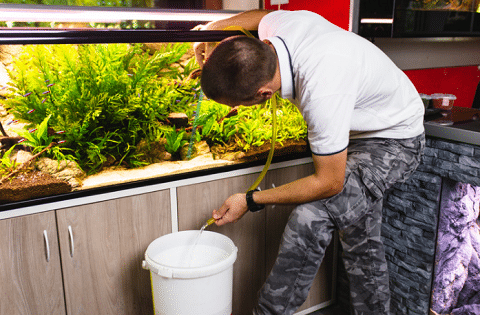
Siphoning is a really cool way of moving water any distance without having to physically carry it or pump it. If you’ve never seen a siphon in action before, prepare to be amazed. The secret? Gravity!
To siphon water, all you need is a flexible hose and a tank that is above ground level. Even though the water in the hose has to travel uphill in a pipe initially to get over the rim, gravity will still pull the water out of the tank.
There is a catch though, this will only work if the end of the pipe (where the water flows out) is lower than the start of the pipe(inside your aquarium).
How To Start A Siphon
To get the siphon started, you need to get water to the point where it has filled the tube past the highest point, and then it will flow. Let’s look at a few ways to do this:
Suck On The Pipe
This is an old-school but messy way to siphon water out of your tank. Although many people still use this method, it is not advised because you can easily get some dirty tank water in your mouth when doing this.
Fish tank water isn’t necessarily dangerous, but it can contain bacteria and other stuff that could be harmful, so never risk swallowing it. If you do get water in your mouth, spit it out, and rinse out your mouth with clean water or mouthwash.
Use A Squeeze Bulb
There are gravel vacuums available that incorporate a squeeze pump on their hoses. By squeezing the bulb, a vacuum is created and the siphon can begin. This is a much easier and cleaner way for beginners to siphon their tanks.
Fill The Tube
You can get a siphon started without a pump if you put the entire hose into the water and block one end of it with your finger. Next, remove the hose end of your gravel vac and lower that end of the pipe to below water level before releasing your finger.
An easier method is to fill the vacuum end of the hose with tank water and invert it so that the water begins to run through the hose. Before all the water has left the hose and drained into the bucket, drop the open end of the vacuum back into the water. If you’re quick enough, the siphon will continue to run.
Use The Python Cleaner
The Python is a mainstay in the fish hobby. Easily clean your aquarium by connecting this to your sink!
The easiest way to remove water from your tank is to use the Python Water Changer. This gravel siphon system connects to your tap and starts the siphon up water with its gravel tube when you open the faucet.
The beauty of this system is that the water from your aquarium drains directly into the sink. This limits spills and mess while saving your back from the strain of carrying heavy buckets.
This is a great system for aquarists with larger tanks. You will have to have a tap nearby for it to work, however.
Gravel Cleaning
The reason that siphoning is so helpful when changing water is that it allows you to suck up physical waste particles on/in your substrate and in the tank water (video source). You can also use the vacuum to disturb the gravel to loosen any particles that are trapped within it. If you have carpet plants and stem plants in your tanks, you can also disturb these gently to release fish waste and mulm.
A great tip is to pinch or fold the hose to control the flow and suction strength of the siphon. This technique is very useful, especially if you’re sucking up too much of your substrate or draining your tank too fast.
3. Refilling Your Tank
Once you have prepared your tap water, conditioned it, and gotten the temperature right, it’s time to add it to the tank.
It’s very important to add new water to the tank slowly. Obviously, you don’t want to spill any water or stress your fish with a sudden powerful current, but the other reason is to avoid disturbing the substrate, especially if you have a carefully arranged tank, or have aquatic plants that can be uprooted.
How To Avoid Disturbing The Substrate:
- Pour the water very slowly
- Pouring the water onto a fish bag on the surface, or through a colander/strainer will help to break up the flow of the water
- Pour onto the water surface with a sprinkler-type fitting
- Pour over hardscape features
- Add water in bags
Even if you’re very careful, you can easily stir up your substrate a little while changing the water. This will make your water a little cloudy. Don’t worry if this happens, your tank will clear up overnight and look amazing the next day.
Safety Tips
Although changing water is a safe and easy thing to do, this is a great time to remind you of a few important safety tips when working with aquariums:
- Water is heavy- Be careful not to overload the surface where you keep your tank.
- Glass is brittle, and broken glass is sharp- If you have a glass aquarium, be very careful never to strike the glass with anything. Be very careful, or rather avoid resting the bucket on the edge of your aquarium glass, especially if you have a rimless aquarium.
- Water and electricity don’t mix well-Turn off your filter and heater while working in your aquarium.
- Take it easy- If you’re using a bucket, take it slow, don’t hurt your back!
FAQS
How often should you do this?
Unfortunately, there is no set timing that will work for all aquarists because each individual tank is different. Once a week, or once every two weeks is good to start out with, and you can adjust your schedule as you find out what works best for you and your tank.
Can you change too much of the volume in an aquarium?
Unless you have some sort of emergency, changing more than 50% of your tank water is not advised because it can be pretty stressful for your fish. As long as the water you are putting in is conditioned, and the same as your tank’s temperature, you could technically do larger changes, however.
What is the best way to do this?
There are many ways to change the water in a fish tank and different methods will work better for different aquariums. If you have a small aquarium, using a bucket and a gravel vacuum is a cheap and easy method if you have a strong back. If you have larger tanks, using a python and a pump might be a better solution.
How often do you do this for a saltwater fish tank?
Performing a water change every week, or every second week is generally recommended for your saltwater or reef aquarium. Just like for freshwater tanks, the volume, and frequency of your changes will depend on a few factors like bioload and feeding amount. Some reef tanks can also get to the point where they do not need frequent water changes or any water changes and can function off dosing supplementation.
Can I completely empty and refill my fish tank?
No, changing all of the water in your aquarium in one go is a bad idea because it will be very stressful for your fish. It will also be harmful to your beneficial bacteria colonies and could disrupt the nitrogen cycle in your tank.
Final Thoughts
Let’s face it, keeping a healthy fish tank does require you to roll up your sleeves every now and then. Performing routine water changes is the number one most important regular maintenance action that you can do.
After reading this article, you’ll have a much better idea of when and how to change the water in your aquarium. Happy water changing!
- About the Author
- Latest Posts
I’m thrilled that you found Aquarium Store Depot! Here you’ll find information on fish, aquariums, and all things aquatics related. I’m a hobbyist (being doing this since I was 11) and here to help other hobbyists thrive with their aquariums! I adhere to a high quality Editorial Process and Review products with real life field usage and practical analysis.

